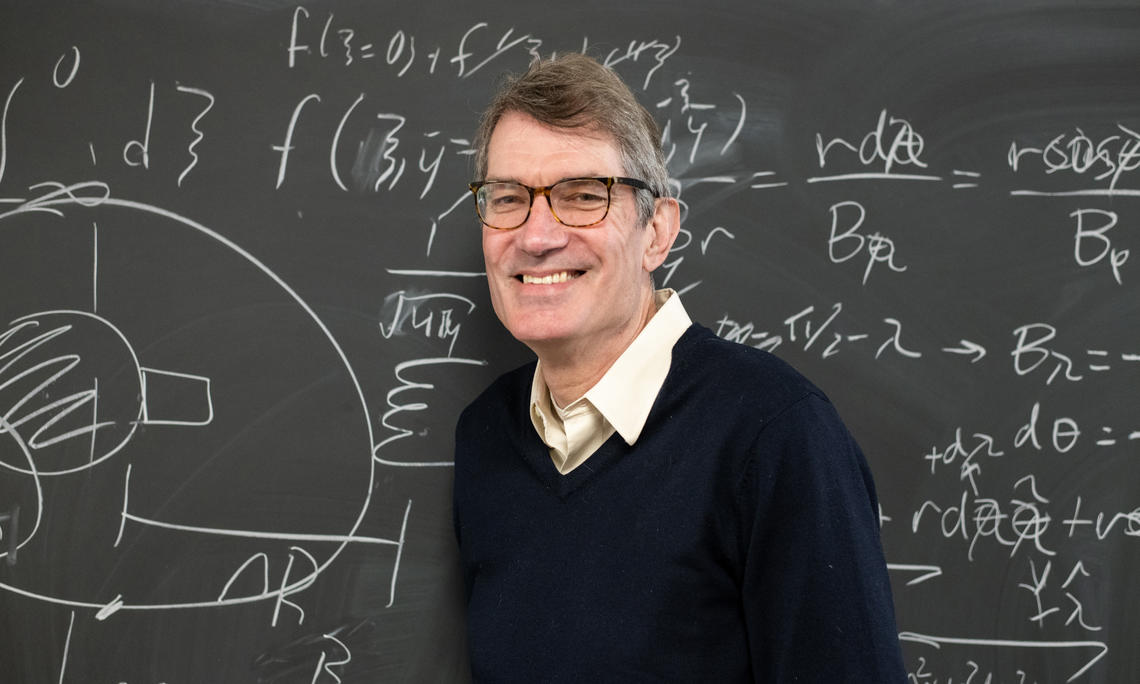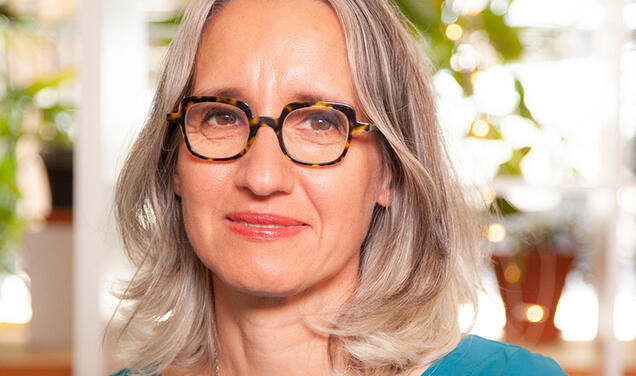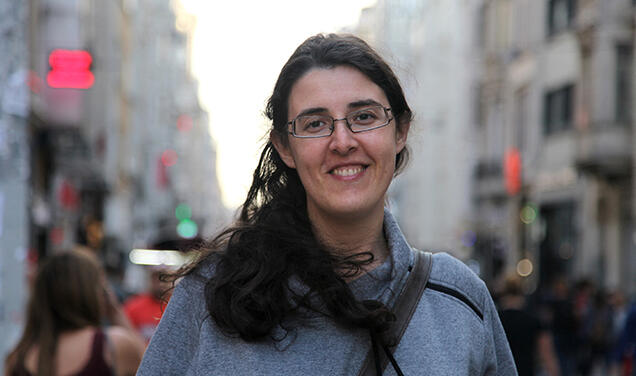Q&A: Princeton Plasma Physics Lab Director Steve Cowley *85 on Fusion and Climate
‘We really need fusion to achieve net zero carbon emissions’

Steve Cowley *85, director of the Princeton Plasma Physics Laboratory (PPPL) sat down with PAW to talk about fusion, climate change, and more.
Highlights:
- Cowley explains the difference between laser and magnetic fusion, the method used at PPPL.
- The PPPL decided to extend into sustainability science because of the national need and impending urgency of climate change.
- The urgency to wean the world off of fossil fuels has never been greater.
- The government has invested billions into climate research.
- Young scientists are needed to innovate.
- What if there was an Apollo program for fusion?
What is most compelling about fusion as an energy source and what do you think is important for the public to understand about fusion?
Fusion is the perfect energy source. It is plentiful, clean, and safe. It has one major disadvantage: It’s hard to do. That’s an advantage if you’re a scientist because when we fully understand fusion, it’ll be an amazing scientific achievement. Right here in Princeton, in 1994, we performed the first controlled fusion experiment that produced significant power. We heated a plasma to around 300 million degrees, and we released fusion energy. If we can figure out a way to sustain energy output, we can power the planet for millions of years. There’s no better way to make energy than fusion. It’s just difficult to heat plasma to 300 million degrees and hold it there while it fuses. Now there’s a challenge.
What was your reaction to the December announcement from Lawrence Livermore National Lab that they have achieved fusion ignition?
That was an incredible result! The National Ignition Facility (NIF) uses what’s called inertial fusion energy, which uses lasers to confine the plasma and then heat it. They used their fusion fuel, which is two kinds of hydrogen — heavy hydrogen and super-heavy hydrogen — and placed it in the middle of a capsule. They compressed that capsule using the world’s most powerful laser, until it reached about a thousand times normal solid density. At that point, a burst of fusion happened inside it. They put in 2 million joules of energy through the laser, and got out 3 million joules of fusion power.
It was the first time at that scale that scientists ever produced more fusion energy output than input. A million joules is about the energy of a candy bar, and it came from a capsule about the size of a peppercorn. It’s a remarkable achievement.
There’s some history here. The research was largely funded for military reasons related to nuclear weapons, and they promised to deliver the results around 2010. That year they fired the laser on the capsule and got essentially no fusion. Researchers at NIF have refined their processes over the past decade with some help from us. Members of our x-ray diagnostics team have been engaged with NIF for well over a decade. They help to measure and analyze shots on the NIF to explain why some shots produce more fusion energy than others.
It was an expensive experiment, but it’s a triumph for science. In many ways, it’s a lesson for all of us, right? Fusion’s going to be solved by smart people doing smart things.
Comparing the process taken at the Lawrence Livermore Lab versus here, how do you see those two different approaches contributing to making fusion commercially viable?
At PPPL, we focus on magnetic fusion energy. This means we hold the plasma in a cage of magnetic fields — we call it a magnetic bottle. It’s shaped just right to hold the very hot fusion fuel, which is in the form of a plasma. A plasma is an ionized gas at very hot temperatures, and holding plasma with a magnetic field is a bit like trying to hold a lump of Jell-O with knitting needles. It is hard work. Researchers must shape the magnetic field lines curve over the plasma and hold it together. Since the founding of the lab in 1951 by Lyman Spitzer *38, it has specialized in understanding the interactions between magnetic fields and plasmas, not only for fusion, but also for other areas like astrophysics.
Magnetic and inertial confinement are two ways to create fusion, and both have advantages. On the inertial side, the NIF laser took 420 million joules of energy to make that laser pulse of 2 million joules. That’s a long way from achieving energy breakeven, whereas magnetic confinement, what we do at PPPL, is closer.
A few more key ideas are needed to really make fusion a commercial viability. We need smart, energetic young people to come into the field with those ideas. It’s the tendency of an old geezer like me to believe we’ve had all the ideas you can have in this space, right? That’s never been true in any area of science and technology. I’m pretty sure we can make fusion electricity, but I’m just not sure that we can make it cost effective. That’s the challenge right now. We need smart, energetic young people to come into the field with good ideas.
Humans always figure it out in the end. The difficulty is we really need fusion to achieve net zero carbon emissions. If you talk to someone like Princeton professor Jesse Jenkins in mechanical and aerospace engineering, he explains the hardest part of getting there is the last bit. We can get 50% or 60% of our energy from renewable energies like wind and solar, but sometimes the wind doesn’t blow, and the sun doesn’t shine. The world needs firm energy sources, as people like Jesse call it. Fusion is a perfect energy source for that.
Do you feel a greater sense of urgency now?
Between the findings of the recent IPCC report and goals like Net-Zero America, led by Jenkins, I do feel the urgency is greater than it’s ever been. We’ve been worried about climate change my entire career as a scientist. It’s become a major issue in the last 10 to 15 years, but in the scientific community it’s been a focus since the early 1980s when I came here for graduate school. Researchers at the Geophysical Fluid Dynamics Laboratory (GFDL) were starting to worry about the effect on global climate models at that time. The urgency of weaning ourselves off fossil fuels, which are still 80% of how we produce our energy, gets stronger and stronger every day.
In fusion, we have a bigger problem, which is that we can see the endgame. We can see ourselves producing fusion pilot plants in about 20 years — by the 2040s. That means that commercial fusion wouldn’t really make an impact until after 2050 because it will take time to develop it as a commercial product and replace existing infrastructure. But that isn’t fast enough. We need something now to go alongside renewable energy. I wish we were ready for that.
My timelines depend on innovation, which can be notoriously difficult to estimate. Look at the progress in A.I. It’s 10 years ahead of where they thought it would be 10 years ago because somebody innovated. That said, there are great researchers in the field of fusion research. PPPL has trained many of the people who’ve had the key ideas throughout history. The leader of the NIF experiment at the Lawrence Livermore National Laboratory, Mark Herrmann *98, was a graduate student here in the ’90s, for example. Part of our job is to find exceptional young people, train them with the skills, and get them to innovate.
How do you see public and private enterprises best working together to do something like bringing down the cost?
PPPL is not the place to make commercial fusion. We focus on the science and engineering behind the development of the fusion and believe public-private partnerships are what will make fusion commercially viable. In the last three or four years, PPPL has started partnerships with about 12 private startup companies in fusion, including some spinouts from the lab. Those private companies have access to resources we don’t have, which is tremendous. They also can move fast and try out new ideas quickly, but they need our expertise. There are probably more than 30 fusion startups that were created in the last five years — indeed a lot of them in the last two years. Some have ideas that will not work. It’s important we keep our scientific integrity, and one of the things our lab can do is inform these concepts with scientific evidence.
About $5 billion was invested in fusion in two years. That’s an enormous amount of cash. It’s because people in the tech industry understand the potential of fusion. The world energy market is probably $8 trillion to $10 trillion a year. If fusion were to do 40% of that, $4 trillion a year is a big business, right? So, there’s a market if you can make it work.
Are there other great advancements recently that have helped fusion?
When Spitzer came here in 1951, he said, “I have an idea how to do controlled fusion” and sent in a secret application to the Atomic Energy Commission to start fusion research in Princeton. He had an idea to make a magnetic bottle that had no electrical current into plasma, called a stellarator. External coils twist the field lines into a three-dimensional configuration. It was a brilliant idea. During the ’50s when the first group was recruited to the lab to work on it, PPPL didn’t have the computers to calculate the theory or the precision in our engineering to realize the idea.
In the ’90s, the Germans revisited his idea designing a device that’s now on the Baltic Sea Coast of Germany called Wendelstein 7-X. It’s the world’s most sophisticated stellarator. It started operating in 2015 on ideas that were partly German and some from PPPL, and it’s getting great results.
As that’s happening, computers are getting faster, and our theory is getting better. In the last couple of years Elizabeth Paul ’15, a presidential postdoctoral fellow, along with a team led by Professor Amitava Bhattacharjee *81, used modern machine learning and artificial intelligence to develop optimized configurations on the computer. They’re unbelievably beautiful to look at, like a sculpture. Spitzer’s ideas are back! Some very interesting start-up companies are taking these ideas forward.
Applying the big advances in computer technology, machine learning, artificial intelligence, and algorithms has been one of the biggest breakthroughs we’ve had.
Can you give an overview of some of the experiments happening at PPPL?
The Princeton Plasma Physics Lab is located off campus so we have the space to scale, which isn’t possible in a normal lab. The NSXT-U is a great example. Many things must come together to make it work. It’s housed in an enormous space. You walk into that room, and you’ll be just blown away by the number of cables around the machine. At PPPL, we can do research on a scale that can’t be done any other place on the planet.
I’ve mentioned plasma, which is the fourth state of matter after solids, liquids, and gases. We’re world experts in plasma physics. We have a responsibility to the government to deliver on our expertise in plasma, which is used across many applications. For instance, roughly half the steps in making computer chips involve plasmas. So while PPPL was created to work on fusion, we’re stepping forward to help innovate the next generation of machines that make the chips in order to meet the incredible competition in microelectronics from countries of the Pacific Rim, including China.
In line with Princeton’s motto, in the nation’s service and the service of humanity, there could be no more important example of it than at PPPL. If we deliver fusion to the nation, it will change the world forever. There’s a certain megalomania about fusion research and the idea of harnessing the power of the stars and having the audacity to think that you might be able to do that.
What led PPPL’s decision to extend into sustainability science?
Essentially, the national need. The Biden administration has put its money where its mouth is on investing in new technologies to make America and the world more sustainable. A certain fraction of that has gone to plasma technologies. I’m glad that Emily Carter, former dean of the School of Engineering and Applied Science, has joined the lab because she, like myself and others in the lab, sees this as an important moment in history to transition the lab into these new areas.
We’re working on a new area of focus under Emily’s purview called electromanufacturing. This replaces fossil-fuel-driven industrial processes with electrical ones often in a plasma. Many industrial processes rely on fossil fuels. If we stopped using fossil fuels to make energy, we’d still be releasing lots of carbon into the atmosphere, with classic cases being the making of steel and ammonia because you burn a whole bunch of coal to make your steel. But with plasmas, you can target exactly the chemical pathways you want to go through. This is called plasma catalysis, and much of the focus of our sustainability growth will be in conjunction with the University. We’re collaborating to try and develop those techniques moving forward — removing fossil fuels from manufacturing processes and replacing them with much more surgically and scientifically derived processes that can use electricity.
The Department of Energy is investing $52 billion in funding to support this research over the next five years. We’re hoping top-quality research institutions like Princeton University and Princeton Plasma Physics Lab can step forward and advance that research for the country.
How often do you get asked when fusion is going to happen, and do you ever get tired of answering it?
When I give public talks, someone usually repeats the joke about fusion, that it’s 30 years away and always will be. I smile benignly and say, “Haha, right,” because I’ve heard that joke since I came to Princeton as a 22-year-old to work on fusion. As a scientist, you answer something like that by saying, “Look, we’ve made progress.” Last December, NIF produced more fusion energy than what went into the capsule. That is a remarkable thing. If you’re making progress in science, you’re approaching your end goal. You’re not standing still, right? As you peel off the layers of the onion, you tend to see more things that must be solved. It’s true that we thought the problem was a lot easier back in 1951 than it clearly is.
The other question that I get asked is if we had an Apollo program to do fusion as fast as possible, what would we do? Would you get there faster? I’m currently working and talking with a bunch of people about a sort of low-risk electrically-producing machine that we could build today, which requires no innovation whatsoever if money wasn’t a factor. We probably wouldn’t get the money to do it, but it’s a good idea to have in your back pocket what you would do if there’s a rapid acceleration.
Interview conducted and condensed by PAW staff










No responses yet